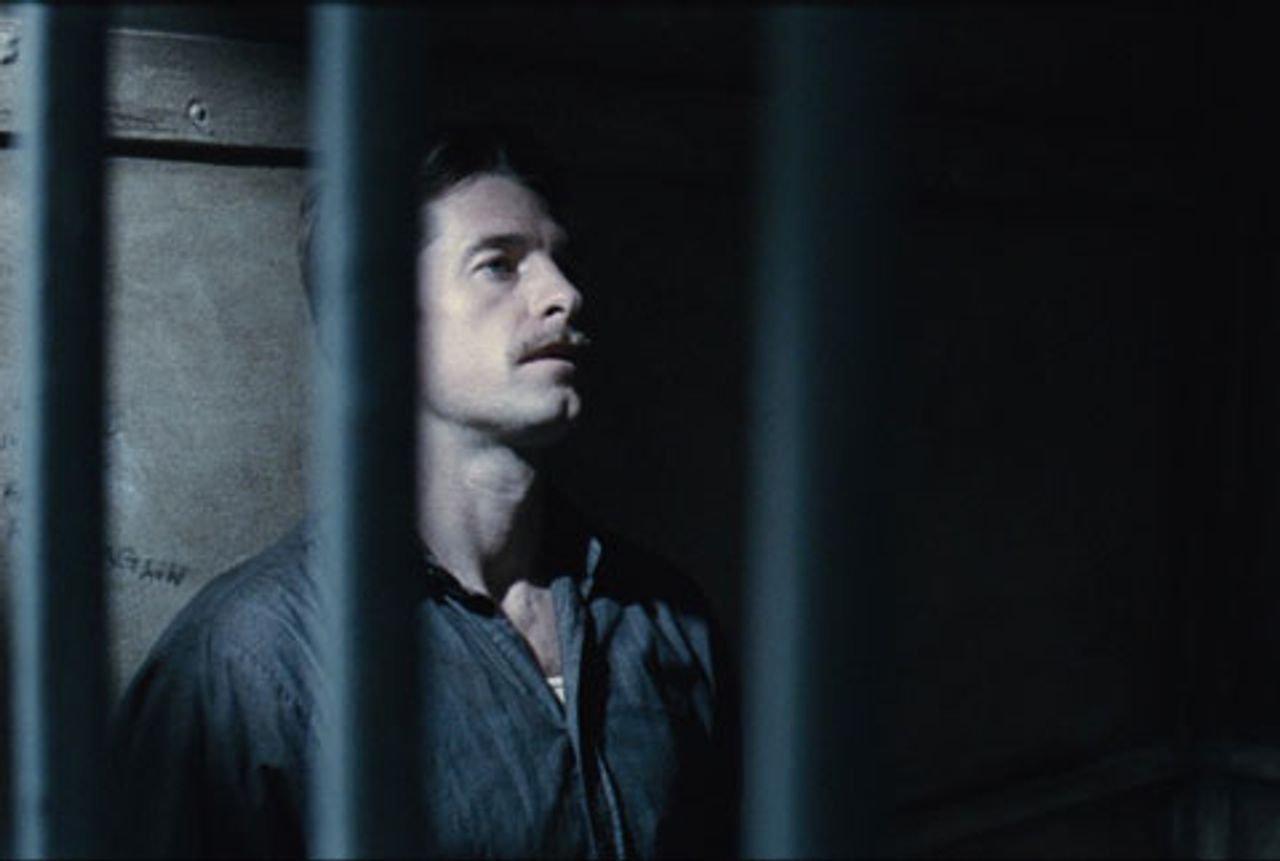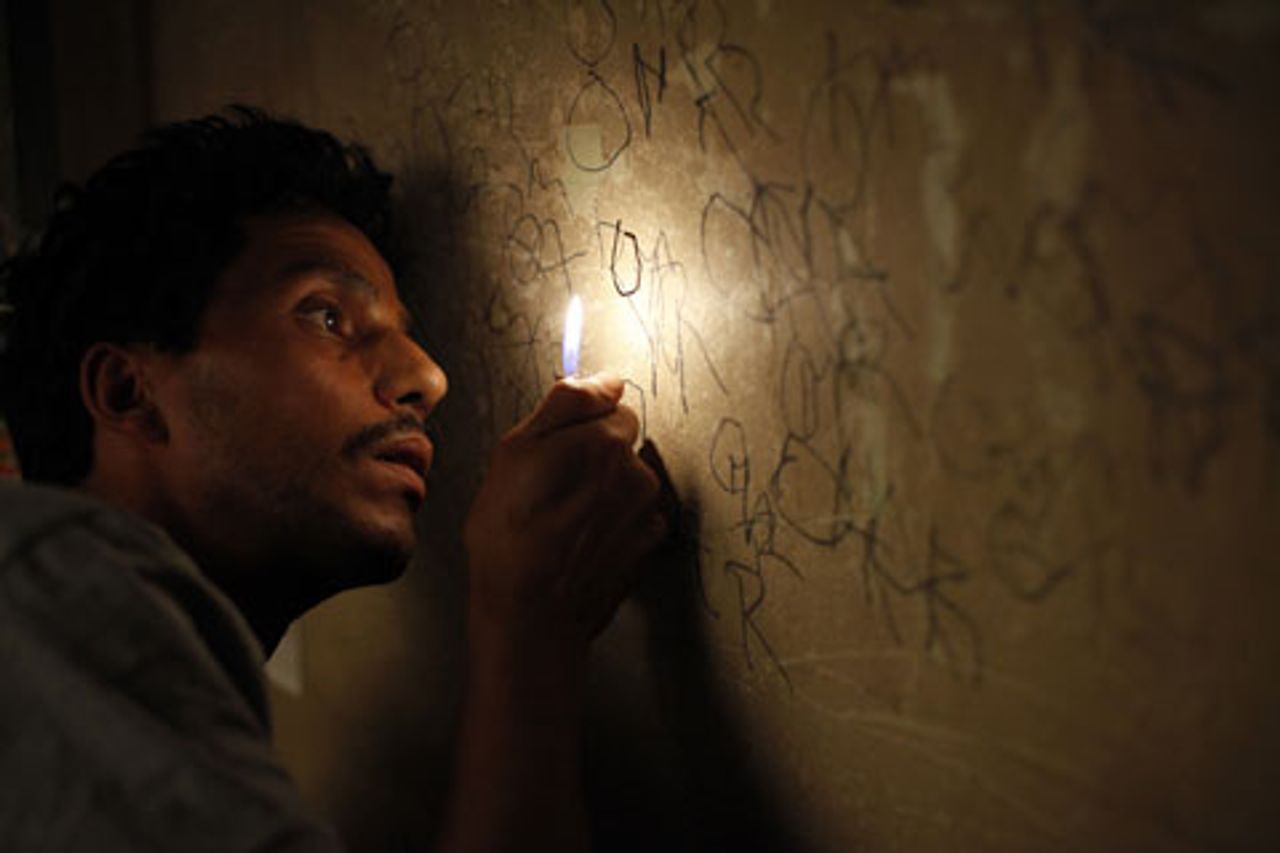This is the first of a series of articles devoted to the recent Toronto film festival (September 8-18). [Part 1][Part 2][Part 3] [Part 4] [Part 5]
The recent 36th Toronto International Film Festival (TIFF) screened some 335 features and shorts from 65 countries. The event is often described (and likes to describe itself) as “the most successful public [film] festival in the world,” although the meaning of that phrase is a bit obscure.
In any case, the festival apparently grows more and more significant to the film industry each year, and the “talent” on hand becomes more and more tabloid newsworthy. Each morning during this year’s festival, the one thousand or so journalists received e-mailed instructions on that day’s “Red Carpet” events—i.e., major screenings. For example: “Red carpets lock 15 minutes prior to talent arrival—this means media cannot access the carpet after that time. Media check in starts one hour prior to carpet lock. Please note: media cannot leave until talent has cleared the carpet.” One could only feel mild repugnance.
(During one press conference this year, it was reported to me, journalists were so irritated by the behavior of a particular film’s producers, who prevented anyone from exiting the room until the “talent” had first all left, that they momentarily refused to allow the producers themselves to depart. That sort of mutiny, unhappily, is a rare event.)
The festival organizers attempt to navigate a course between the imperatives of large financial interests and the objective impulse of global filmmaking, which tends toward criticism of a society dominated by those same financial interests. In that contradiction, which is an untenable one in the long run, lies the peculiar character of the annual event.
On the one hand, the picture that emerges of contemporary global society from the most substantial works presented at the Toronto festival is not a flattering one. The artistic approaches and themes in the various examples of more socially minded filmmaking are varied (and by no means uniformly successful or convincing), but over the course of dozens of screenings, one is brought face to face with poverty past and present in North America; political repression in Turkey and Iran; corruption and social misery in Uzbekistan, Slovakia, Britain, South Africa, China, Tunisia, India, Portugal, Morocco and the Gaza Strip; official violence in Australia and Spain; the plight of African refugees in Europe; political conspiracy in the UK; the brutality of French imperialism in its overseas territories; and other realities.
Some of the films that seemed most interesting to us, from the dramatic and social points of view, included Omar Killed Me from France, about the frame-up of an innocent Moroccan immigrant for murder in the 1990s; Think of Me, about a single mother trying to stay afloat in contemporary Las Vegas; Rebellion, about the suppression by the French authorities of a revolt in New Caledonia in 1988; Future Lasts Forever, a moving film about the legacy of political repression in Turkey; Habibi, about the plight of a Palestinian couple, confronting many obstacles to their love, in Gaza; The Tall Man, an Australian documentary about the police killing of an Aborigine in custody in 2004; 11 Flowers, about life in small-town China during the mid-1970s; Beauty, the portrait of a brutally repressed and repressively brutal middle-aged Afrikaner in South Africa; Free Men, about Algerian Muslims in Paris during World War II rescuing Jews from the Gestapo; Wim Wenders’s documentary study of the late dancer Pina Bausch and her company, Pina; The Deep Blue Sea, another consideration of doomed love from Britain’s Terence Davies; and Edwin Boyd, about a small-time bank robber in Toronto during the postwar years (more about this below). We will take a look at some of these films in subsequent articles.
 Edwin Boyd
Edwin BoydOn the other hand, the noxious presence of major corporate sponsors at the Toronto festival has become ubiquitous, from the name of the new downtown festival headquarters itself—TIFF Bell Lightbox—to every public screening of a film at the festival, where those sponsors are endlessly thanked. The Globe and Mail noted in September 2010: “The Lightbox demanded a significant investment on the part of corporate sponsors (which include Bell Canada, Royal Bank of Canada and Research In Motion, whose brand is stamped on the building’s BlackBerry lounge), private donors, the federal and provincial governments, and the developers themselves. Mr. [Noah] Cowan [artistic director of programming] said the single biggest donor was the King John Festival Corp. The Lightbox sits on Reitman Square, land owned by Hollywood producer Ivan Reitman and his family, which also partly runs KJFC.”
With the development of social struggles in North America and elsewhere, how long will it be before the presentation of a given work, one that strongly challenges the status quo, proves unpalatable to the establishment figures who currently facilitate and even fund the festival’s smooth running? What sort of crisis will that precipitate?
We had a foretaste of this two years ago, when festival organizers responded with considerable hostility to a protest against their official celebration of Tel Aviv, only months after the horrific massacre perpetrated by the Israeli military in the Gaza Strip. When events come closer to home, the degree of hostility is likely to grow. Although, the entertainment industry being the singular beast that it is, political opposition may also emerge in surprising quarters.
Currently, the festival organizers seem dizzy with a success that, frankly, more or less fell into their laps as the result of changes in global economics and the structure of the film industry over the past two decades and the various benefits of holding such an event in Toronto.
In early 2010, officials trumpeted the results of a study which estimated that the film festival generated an annual economic impact of C$170 million. With the opening of its new headquarters, the TIFF Bell Lightbox, the festival was expected to generate C$200 million by 2012.
According to the Commerce Times web site, Peter Finestone, film commissioner for the city of Toronto, asserted that the festival helped the city be more competitive in terms of tourism, business visitors and conventions. “[The Festival] makes a huge contribution in terms of raising the profile of the city,” declared Finestone. “As a film festival it drives film studio executives to Toronto and has them get a bit more familiar with the city. In that sense it assists in selling the jurisdiction to major studios [and] independent film companies, as a place to come and make their movies.”
The economic impact study indicated that tourists drawn to the film festival spent C$27 million in Ontario in 2008 and that C$60 million of tax revenue was generated through year-round film festival activities and construction associated with the Lightbox.
It is permissible to take some of the more grandiose claims about the economic benefits of the film festival with a grain of salt. The festival commissioned the year-long study in 2008-2009, which was funded by the Ontario Ministry of Tourism and Culture, the Ontario Media Development Corporation and the City of Toronto, all interested parties. “In addition, the Ontario Ministry of Tourism and Culture engaged an independent study by TNS Canadian Facts to determine the tourism impact of the 2008 Toronto International Film Festival.”
Nevertheless, there is no question that companies and individuals spend millions of dollars during the festival’s 10 days or so. What sort of economic or cultural benefit this produces for the average working class resident of Toronto, many of whom would likely find the cost of a single ticket (about C$21) an obstacle to attending, is another question.
This is an issue that bears thinking about for a number of reasons. To most of those who come on business to the festival, social conditions in the host city are of little interest. (That 57 percent of the industry “delegates” who attend enjoy household incomes of more than C$100,000, and 23 percent more than C$150,000, according to the same 2010 economic impact report, is not immaterial in this regard.) To many attendees, “Toronto” is merely an adjective that goes first in the festival’s title, an event more readily identified with a handful of upscale hotels, bars and restaurants.
In fact, general conditions of life in Toronto are changing for the worse, in line with decades-long trends and, more immediately and dramatically, attacks on the working population everywhere since the financial crisis of 2008. One sees it on downtown streets. The number of people picking through the garbage or sleeping on sidewalks, including only a block from the festival’s Lightbox, has increased.
Statistics bear out one’s personal observations. More than 600,000 people in Toronto now live at or below the official poverty line. The city’s welfare caseload grew by 15 percent between December 2008 and December 2009. Food bank use increased by 14 percent from 2009 to 2010.
 Omar Killed Me
Omar Killed MeAs the WSWS noted a year ago, “On any given night, an estimated 5,000 people sleep in shelters or on [Toronto] city streets. In 2009, 33,000 people were homeless sometime over the course of the year. For those who do have jobs, the average hourly wage has been virtually flat for two years, coming in at $22.86 per hour in one of the most expensive cities in the world. Rental rates are so high that a quarter of a million households spend at least 30 percent of their monthly income just to keep a roof over their heads. And of those households, fifty thousand are forced to devote half of their monthly income to housing. Meanwhile, Toronto rents continue to rise at more than twice the national average.”
According to a poverty fact sheet, the annual income needed to afford a one-bedroom apartment in Toronto is C$38,000. Fifty-five percent of single parents in the city earn less than that, 31 percent of couples and 69 percent of people living alone. In other words, the struggle to make ends meet is an increasingly painful reality for hundreds of thousands in the city.
A study released by the United Way in January 2011 pointed to the increasing concentration of poverty in decaying high-rise rental housing. By 2006, nearly 40 percent of all the families in high-rise buildings in the City of Toronto were poor, up from 25 percent in 1981. The authors point to various reasons for the concentration of low-income tenants in high-rise buildings, including the targeting of new private-sector housing “almost exclusively at better-off families.”
“Housing market forces are only part of the story however,” the report points out. “It is the broad forces of income inequality that have been gaining momentum since the 1980s which have created the conditions for concentrated poverty. This has resulted in a significant decline in the incomes of families, in real terms, over the past 25 years, and an increase in the number of families living in poverty.
“In the City of Toronto, the median income of all households, in adjusted 2006 dollars, declined by $3,580 over the 25-year period, from 1981 to 2006. But the decline among renter households was nearly double this amount, at $6,396. In the inner suburbs, renters suffered even bigger losses in their annual incomes over this period.” Taking inflation into account, household incomes in Toronto have declined by 10 percent over the past 15 years.
Toronto’s right-wing millionaire mayor, Rob Ford, is now spearheading an attack on municipal services and jobs that will result in a further deterioration in the quality of life for the vast majority of the city’s population. The violent suppression of the G20 protests in Toronto in June 2010 by police, 7,000 of whom were deployed in the downtown area, with 1,000 arrests and the use of snatch squads, tear gas and rubber and plastic bullets, revealed the real state of social relations in the city and the country as a whole.
One would think that conditions of life in the nation’s largest city and metropolitan area might intrigue Canadian filmmakers (southern Ontario as a whole contains some 25 percent of the country’s population). Yet, alas, in the nearly two decades I have been attending the festival, I can count on the fingers of one hand the number of works dealing dramatically with that general subject.
 Think of Me
Think of MeHowever, films made in Canada treating matters generally lumped into the category of “identity politics,” gender, sexuality, race, etc., have never been in short supply. No, never in short supply, but not very interesting or illuminating either, for the most part.
For that reason, it seemed of some objective significance that the 2011 festival presented a work that depicted social relations in Canada in a relatively harsh light, that did not take as its premise the “kinder, gentler” nature of capitalism there, that scraped away the surface and discovered the brutality of the social order.
This was Edwin Boyd, directed by Nathan Morlando. The film offers a fictionalized account of a real-life bank robber in Toronto in the late 1940s and early 1950s.
In Morlando’s film, Boyd (Scott Speedman) returns from World War II, with a British wife (Kelly Reilly) and two children, and finds few opportunities for veterans. The family lives in poverty. “I didn’t bring you over from England to live like this,” he says.
Boyd turns to robbing banks, successfully knocking off several before his wife discovers the truth. “I’m not crazy,” he explains in the face of her shock and fright, “the world is crazy. I’m its mirror.” The film captures something important about the realities of postwar life in Toronto, with virtually all its scenes seemingly (and fittingly) shot in raw, cold, grey weather. This was an economically grim time, but also socially volatile. After six years of war and sacrifice, following on the harsh Depression years, Canada experienced a powerful strike wave. In 1949 in Toronto, the year Boyd began robbing banks, a socialist (Trotskyist) candidate won 23 percent of the vote in the city’s mayoral election.
Again, whatever the filmmaker’s conscious intentions, he manages to capture some of this social volatility in an initial scene in Toronto’s notorious Don Jail, where Boyd eventually ends up and from which he breaks out twice. Kevin Durand gives a remarkable performance as the explosive Lenny Jackson, another bitter veteran and one of Boyd’s eventual partners in crime, who lost a foot back in Canada working for the railway.
Although a period piece, Edwin Boyd’s potshots at the banks (during one robbery, Boyd asks customers and tellers, “What good have they [the banks] ever done you?”), its concern with the fate of war veterans, its unsympathetic attitude toward authority, all this speaks to the present-day and present realities in Canada. The inclusion of a scene of a double hanging (Jackson and another gang member were executed in 1952, for shooting a policeman) is grisly and disturbing.
Someone is paying attention, not everyone is fooled.
To be continued
